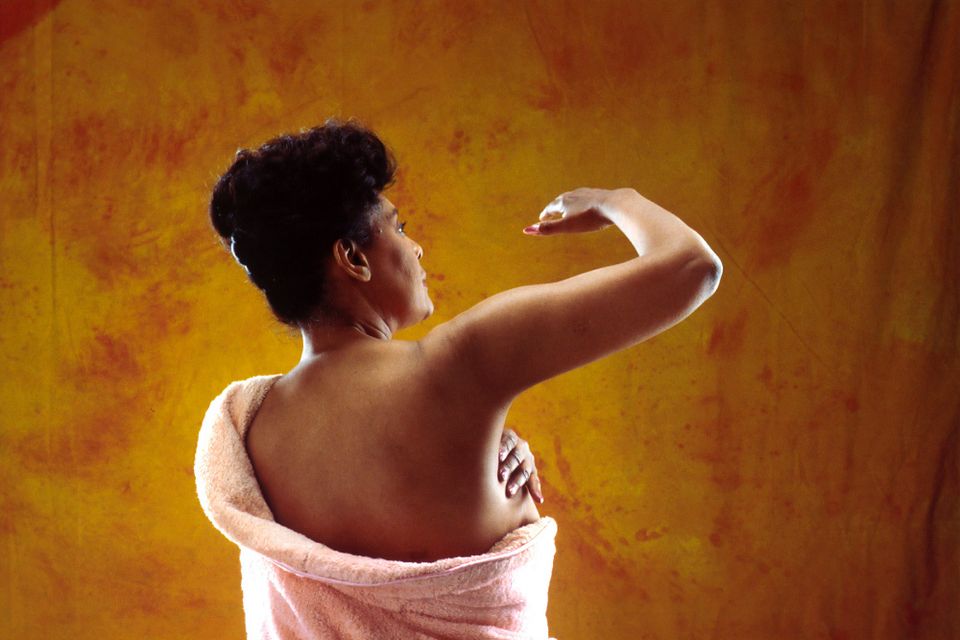Ladies, Check ’em on the First

and Know What You’re Looking For

Everyone knows that October is Breast Cancer Awareness Month. But for me, every month is breast cancer awareness month since my diagnosis a year ago. I’m coming up on my one-year cancerversary and a routine check-in the shower caught my cancer early.
I had my first scheduled screening mammogram 18 months prior to my diagnosis. I waited for five days and received the results via email that everything looked normal and to come back in a few years.
A few years for your next mammogram is too long. My gynecologist recommends going in annually starting at the age of 40.
Check yourself on the first of every month
Ladies, check yourself on the first of every month. If you check yourself regularly, you’ll know before a mammogram when something has changed.
Because of my diagnosis, my daughters will need to start their annual screening mammograms 10 years earlier than when I was diagnosed. Instead of starting their mammograms at age 40, they’ll need to start their annual exams at 31 years old since I was 41years old when I was diagnosed with breast cancer. I’ll be teaching my daughters to check it on the first when they begin to develop.
When I checked, there was a small knot, the size of a pea, on the outer part of my right breast. For those who have had mastitis, it felt exactly like a clogged duct. The kind you’d get when you’re nursing babies. Except for this time I didn’t have the accompanying fever or hot spots. It hadn’t been there before and it made me concerned enough to schedule an appointment.
If something seems different, set your mind at ease, and make the appointment. If I had waited, my prognosis could have been worse. My oncologist diagnosed me with HER2+ breast cancer, an aggressive form of breast cancer.
There is no history of breast cancer in my family and when I did the genetic testing there was no reason why I was diagnosed with breast cancer.
As the geneticist put it: “Well, the good news is that you do not have a genetic predisposition for cancer. The bad news is, we don’t know what’s causing your breast cancer. We don’t know why you have it. You just do. I’m sorry.”
My geneticist suggested that I come back in a few years and get another test done. By then they may have discovered more markers for cancer and maybe they’ll be able to give me better answers for my diagnosis that will help my daughters.
Signs to Look for
When you are doing your own self-check, look for the “official” 12 signs or symptoms of breast cancer:
- Thick area
- Dimple
- Nipple crust
- Lump
- Red or hot
- New fluid
- Skin sores
- Growing vein
- Sunken nipple
- New shape/size
- Orange peel/skin
- Hard lump
I had number signs number 6 and 12. I didn’t know that discharge was part of possible breast cancer. I had a milky discharge every now again after a hot shower. It looked like breast milk and I didn’t think anything of it. Now, I know better that I should have had that checked. There’s no harm in bringing up concerns in a doctor’s appointment. Especially if it’s something unusual.
The hard lump was much easier to tell because it felt exactly like that, a small hard lump the size of a pea.
There are six ways to detect breast cancer early:
- Self Check — Find something unusual
- See your doctor (a note here: I wasn’t sure if I should see my gynecologist or my general practitioner. A friend recommended the gynecologist because they are more familiar with women’s bodies. I mean, it is their specialty. My gynecologist is the one who did a breast check to confirm the bump and then recommended and scheduled all of the follow-ups)
- Mammogram (This was the first appointment my gynecologist scheduled after confirming the lump with a physical exam).
- Ultrasound (My gynecologist also put in an order for me to get a breast ultrasound. Because he was proactive and put in this order, I didn’t have to wait for the ultrasound when my mammogram was immediately inconclusive).
- MRI (I didn’t get an MRI. Maybe I didn’t need one because both my mammogram and ultrasound were inconclusive. The doctor who viewed both the mammogram and ultrasound images made the immediate decision to have me get a biopsy).
- Biopsy — This is when they extract tissue from the area of concern. I was lucky. I had the mammogram and the ultrasound on the same day and then they scheduled for a biopsy an hour later. As a result, I received my diagnosis within four days of my mammogram/breast ultrasound/biopsy.
You can go to knowyourlemons.com for more information about looking for signs and symptoms of breast cancer.
What to expect at your annual screening mammogram
Today, I went in for my regular diagnostic mammogram. A diagnostic mammogram is a little different from a screening mammogram. The technician will take more pictures from different angles because they already know that there is a problem, like in my case of already being diagnosed with breast cancer.
Never had a mammogram before? Imagine having someone closing a refrigerator door hard on your breast, repeatedly. It’s just as fun as it sounds.
Before you arrive, make sure you haven’t used any lotions, powders, soaps, or deodorant before your appointment.
When you get to the office, they may have you fill out a basic questionnaire asking about your family history of breast cancer, if you’ve ever been pregnant, or given birth, if you are on birth control or hormone replacement therapy.
They also ask if you’ve ever had breast cancer and the time of your diagnosis and treatment. They’ll ask if you are having trouble with your breasts. If you’ve noticed anything unusual, this is the time to speak up!
It was a bit of a gut punch the first time I had to fill out the questionnaire and was asked if I had been diagnosed with breast cancer. I was sitting in the waiting room with my bald head hidden underneath a head wrap. I didn’t even have eyebrows at the time. Yes, I had breast cancer and yes, I had just finished my last cycle of chemotherapy. It was why I was sitting in the office just months after my last mammogram.
The technician who performed the mammogram was a little gentler in the way she spoke to me. The whole cancer questionnaire makes the technicians aware that this is an experience that causes a lot of anxiety in women, especially breast cancer patients and survivors.
In the back of our minds, we’re waiting for them to tell us that our cancer has returned. I don’t think this is a fear that will ever be alleviated. It sits in wait, like a lion waiting to pounce.
When they take you back you are asked to take off your top and upper undergarments in a small changing room. You can keep on your regular clothes on your bottom half. Take off your necklace if you’re wearing one. They don’t want you wearing anything from the neck to your waist.
They’ll walk you back to the room where you will get your imaging. They should give you a lead apron to wear that covers your stomach/womb area. If you’ve never worn one before it’s heavy.
If you are pregnant or breastfeeding, you need to tell them. They will have you take a pregnancy test before your appointment if there is any chance you are pregnant.
Let the technician maneuver you. The technician told me, “Let me do the work. I’ll move your body and your arms. You just stand there.” Whenever I get a mammogram I stand wherever they tell me and I let them move my body (arms, breast, head, legs) where they need them to get the best picture. They are professional and it’s very clinical.
While they are taking the picture do NOT MOVE or BREATHE so that they can get the clearest pictures. They’ll check the image. If it’s not right, they’ll take it again. The way you can be most helpful is to let them do what they need to do to get you in the right position and follow all of their directions.
No lie, it’s really uncomfortable. The plates have to be nice and tight when they take the picture. It hurts. My chest was red after I was done. Because I still have a port, the tech worked really hard so that it wouldn’t include the port in the picture or tug on the area around it.
When they’re done, they’ll send you back to the changing room and contact you later for your results. If you’ve been diagnosed with cancer, they may keep you in the imaging room in case they need to take further pictures or send you for a follow-up to another department.
A year ago when my image was inconclusive, they sent me immediately for an ultrasound. That might not happen in all cases, but it’s a possibility. It just happened that my ultrasound was also inconclusive, and they sent me directly for a biopsy. That does not happen in every case, but it could.
Then you’re done. Go home and put your feet up and know that you have taken care of yourself in an important way.
Keep checking them on the first, ladies! Your body will thank you.
Author’s Note: I am not a medical professional. I am a cancer patient who is still in active treatment. I provide my experiences in the hopes of helping other women. Every woman’s experience is different. Please see your physician for questions and concerns. Your body will thank you.


